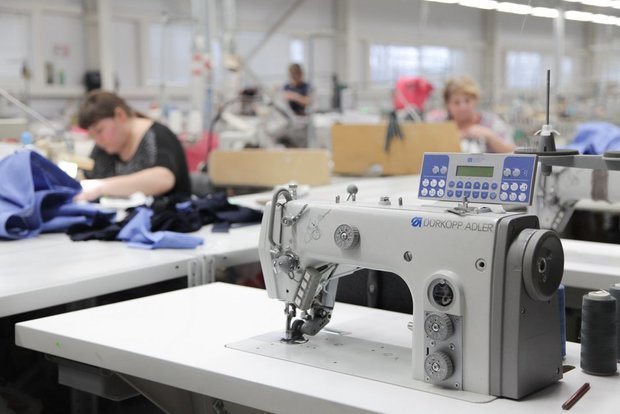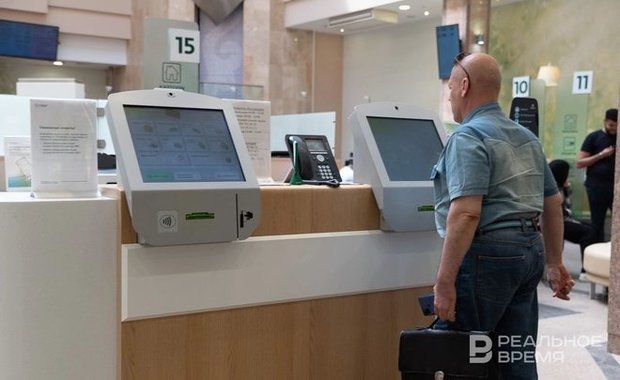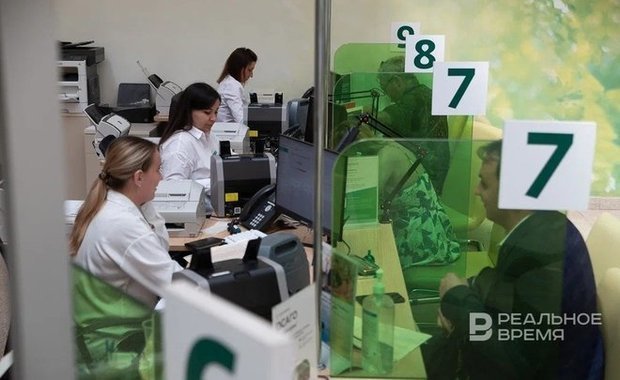Tatarstan’s businesses take out loans worth 800 billion

Lending to small and medium-sized businesses is growing at a faster pace than the segment of large enterprises. Preferential loans and state support within the framework of the Small and Medium-sized Entrepreneurship national project remain the main driver of growth. The total amount of liabilities of legal entities and sole proprietors increased by 20,5% to 816,9 billion rubles as of July 1 in Tatarstan. At the same time, the loan commitments of the largest enterprises increased by 17,6% in annual terms, and of SMEs — by 25,8%. How the tightening of monetary policy and the increase in the key rate are affecting the market and whether there are risks in the rapid growth of lending to SMEs — in the review of Realnoe Vremya analytical service.
Businesses borrow over 800 billion rubles
In the first half of 2023, 568,9 billion rubles of new loans were issued to legal entities and sole proprietors, which is by 20,6% more than in January-June 2022. This dynamics is due to an increase in the volume of lending to small and medium-sized businesses (+30,4%, up to 224,7 billion rubles in January-June 2023), the Bank of Russia — National Bank of the Republic of Tatarstan told Realnoe Vremya.
The volume of loans issued to the largest borrowers in the first half of the year increased by 15% compared to the same period last year — to 344,2 billion rubles.
The total amount of obligations on loans to legal entities and individual entrepreneurs increased by 20,5% as of July 1, 2023 compared to July 1, 2022 and amounted to 816,9 billion rubles. Loan liabilities of the largest enterprises increased by 17,6% in annual terms, to 511,7 billion rubles, loans of SMEs — by 25,8%, to 305,2 billion rubles.

Such indicators are largely related to the implementation of the Small and Medium-sized Entrepreneurship and Support for Individual Entrepreneurial Initiative national project. Thanks to the national project, Tatarstan businesses have attracted debt financing for a record amount of more than 10 billion rubles since the beginning of the year, the Ministry of Economy of the Republic of Tatarstan said in a statement.
Tatarstan is ahead of Moscow
Today, the republic is the leader in Russia in terms of preferential investment lending to small and medium-sized businesses. In total, investment loans in Russia are approved for 658 SMEs for 79,4 billion rubles. The second place after Tatarstan (where 6,2 billion rubles were attracted) is occupied by Moscow with the amount of 6,1 billion rubles, the third place is Novosibirsk Obalst with 4,8 billion rubles. Also, the top five include Sverdlovsk Oblast and Perm Krai with amounts of 4,7 and 3,6 billion rubles, respectively.

The programme of preferential investment loans was launched in August last year due to the combination of preferential loans under the Small and Medium-sized Entrepreneurship national project and the programme of stimulating lending by the Bank of Russia and the SME Corporation. Today, small and medium-sized businesses from priority sectors of the economy can receive preferential loans from 50 million rubles under the programme: manufacturing, hotel business, professional scientific and technical activities. The programme rate is tied to the value of the key rate.
SME lending has been growing for the second year in a row
Unprecedented external pressure on big businesses last year led to that banks reduced the volume of its financing — compared to 2021, a decline in disbursements amounted to about 27% and increased the interest of banks in the SME segment, according to a study by the Expert RA rating agency. The launch of the parallel import mechanism and the reorientation of logistics chains to friendly countries, the development of niches of foreign companies that have left the Russian market, as well as the inflationary factor supported the demand for loans from SMEs.
As a result, in 2022, about 17% of loans to resident legal entities fell, according to the Bank of Russia, to small and medium-sized businesses, while in mid-2020, against the background of the crisis caused by the coronavirus pandemic, this figure dropped to 9%. As a result, by the end of 2022, the SME lending segment showed significant growth — the volume of disbursements amounted to 11,4 trillion rubles, which is by 8% more than a year earlier, and the loan portfolio increased by 30% to 9,6 trillion rubles, showing a new maximum.

Government programmes continue to play an important role in supporting the market. According to the Ministry of Economic Development of the Russian Federation, in 2022, small and medium-sized businesses attracted more than 1,3 trillion rubles of credit funds through state support instruments, including through the new “umbrella-type” mechanism of guarantees of the SME Corporation and products of regional guarantee organisations.
In 2023, the Russian economy continues to transform, which requires the replacement of products and services of withdrawn foreign companies, as well as the restructuring of foreign economic relations. In this regard, Expert RA expects that lending to SMEs will continue to grow this year, which will be supported by both the demand for credit funds from borrowers and the high interest of banks in working with this group of clients against the background of increased risks and compression of demand in the large business segment.
One of the factors of credit growth is the active development of state programmes aimed at supporting small businesses, the press service of the Tatarstan branch of Sberbank confirmed to Realnoe Vremya. The largest amount of funds issued in Sber fell on the MER 8,5%/9,95% programmes, preferential lending to the agro-industrial complex, Umbrella-type mechanism for providing guarantees to the SME Corporation, as well as on joint programmes with the Guarantee Fund of the Republic of Tatarstan in terms of providing guarantees.
Sergey Pankovets, the director for work with corporate clients of Rosbank in the Republic of Tatarstan, believes that the growth of business lending is largely due to that companies adapt to market realities quickly enough and are ready to increase the volume of work.
In the segment of medium and large businesses, Rosbank's portfolio has grown by 60% since the beginning of 2023, he noted. The number of active loan agreements has increased 2,3 times. The loan portfolio of corporate clients in Tatarstan increased by 55,6% in the first half of 2023. Not only credit products were in active demand, but also bank guarantees (+41,9%).
The most confident development, according to him, is shown by the enterprises that focus on domestic demand and were able to replace the retired foreign players. This includes businesses from the areas such as food industry, production of essential goods, pharmaceuticals, wholesale trade, as well as companies related to government procurement, he listed. “At the same time, many trading, manufacturing, and service enterprises have faced a shortage of working capital, since suppliers are not always ready to provide commodity loans," Pankovets noted. “This factor also contributed to an increase in demand for credit resources from businesses.”
Rosbank also noted the increasing number of customer requests for various programmes with state support.
Bank of Russia points out the risks
At the same time, the Bank of Russia warns that the quality of loans in SMEs is worse than in other segments, even despite a decrease in the share of the most problematic loans of the IV—V quality category (pre-default and default categories). In 2022, they occupied 8,2% of the entire portfolio. In absolute terms, about 780 billion rubles of loans were problematic.

The deterioration of the quality of the SME loan portfolio is indicated by at least three factors, the Central Bank lists. In particular, the very decline in the share of “problem loans” is due to the active growth of the portfolio — the volume of such loans actually practically does not change.
Besides, if we exclude loans from the calculation to developers who are reliable borrowers, but conditionally belong to SMEs, then the share of problem loans will be higher — about 11%. The third factor confirming the Central Bank's concerns is the high volume of restructurings: 1,7 trillion rubles (approximately 18% of the portfolio) for 2022.
Tatarstan is an island of stability

One of the reasons for economic growth is active lending to the economy of Tatarstan. Moreover, in the republic, despite the last banking crisis, many regional banks have been preserved. First of all, of course, the large banks of the republic should be noted, the expert says. “The presence of our own regional banks contributes to the growth of lending to enterprises in the region. Besides, the inclusion of the republic among the pilot regions for testing partner (Islamic) banking will also contribute to the growth of financing of the regional economy," he believes. “Tatarstan will undoubtedly be the leader among the four regions included in this experiment.”
A sharp increase in the key rate will certainly contribute to a slowdown in lending and a weakening of the recovery processes in the economy, Maxim Osadchy believes: “Moreover, the head of the Central Bank, Elvira Nabiullina, said on September 1 that a further increase in the key rate is not excluded. However, hopefully, preferential business lending programmes with reduced rates will continue to work," the expert notes.
Small businesses have taken an important role in import substitution

This dynamic is largely due to that last year SMEs received a significant boost to development against the background of economic restructuring and external sanctions pressure on large businesses — small and medium-sized enterprises have become an important link in logistics chains, as well as in the development of niches of companies that have left the Russian market. Besides, the gradual decline in interest rates, which was observed in the 1st half of 2023, also contributed to the development of lending.
Loans are going to become more expensive
The trajectory of credit rates always repeats the Central Bank's rate, and the cost of a loan against the background of the recent increase in the key rate to 12% per annum is also going to increase.

If the conditions of the external and internal environment do not improve, inflation continues to grow strongly, and the ruble does not strengthen, the Bank of Russia will continue to tighten monetary policy and raise the rate again in the autumn, the expert predicts.

In Russia as a whole, the situation with corporate lending is similar. According to the Central Bank, the portfolio of loans to legal entities of Russian banks as of the end of June increased by 19,8% in annual terms, and the portfolio of loans to SMEs — by 31,9%.
However, the recent sharp increase in the Central Bank's key rate will lead to a certain “cooling” of corporate lending in the country in the coming months, the analyst agrees. Nevertheless, according to his estimates, it is possible to count on the growth of the portfolio of loans to legal entities at the end of the year at the level of 12-13%.